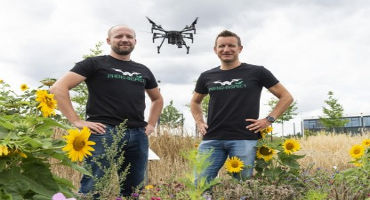What's the growth like? Have pests and diseases struck? Are the increased droughts affecting the plants? Breeders of new varieties have to collect extensive data on these questions. The start-up "Pheno-Inspect" of the University of Bonn wants to accelerate plant cultivation. Camera-equipped drones record the crops, software then automatically evaluates their properties using artificial intelligence methods. This indicates very quickly whether the new breed is a success. The project is supported by the "START-UP University Spin-offs" program with around 270,000 Euros.

With a gentle hum the drone flies over the plant breeder's fields. During the flight it continuously takes pictures of the plants, which are later analyzed automatically using artificial intelligence. The breeder can then use the results to evaluate which varieties are particularly suited to the breeding objective. "Global population growth means that agriculture will have to produce even higher yields in the future, while the area of the arable land remains the same," says Philipp Lottes, research associate at the Institute for Geodesy and Geoinformation at the University of Bonn. "The current bottleneck in the development of new and better varieties is high-throuput phenotyping in the field."
This is still a very complex process in plant cultivation. In phenotyping, experts determine the appearance - or phenotype - of plants: How big are the ears of wheat in a new variety? Does the crop suffer from pests or diseases? How does the plant cope with drought? "Only when these data are statistically secure do breeders know whether their new hybrid is a success compared to other varieties," reports Lottes. In the future, this data could be collected automatically using artificial intelligence. The start-up "Pheno-Inspect", of which Lottes is the founder, is forging ahead with these plans.
Self-learning automatic computer methods
The geodesist already investigated machine learning methods for plant recognition in his doctoral studies, which he also wrote at the University of Bonn as part of the "PhenoRob" Cluster of Excellence. In the course of this he developed methods for using drones to take pictures of crops, from which software is able to determine, for example, the number of cultivated plants, the distribution of different weeds as well as infestation with pests and diseases. "These are self-learning, automated processes that optimize themselves on the basis of user specifications," reports Lottes. In a "training phase", the software learns what grain ears, dry stress symptoms or weeds look like on the basis of a large number of photos. Using statistical methods, the analysis program can then automatically evaluate images and provide comprehensive documentation in the form of maps that show which of the breeding plots suffer from nutrient deficiencies or which are especially high-yielding. "Particularly the fully automatic evaluation of the data on a large scale has great potential," explains Prof. Dr. Cyrill Stachniss.
During the inspection, the drone flies at altitudes between ten and 100 meters above the crops. No blade of grass escapes the cameras, because the resolution provides detail down to a few millimeters. "The positioning is done via a very precise GPS, as used by geodesists," reports Lottes. "Smartphone GPS cannot compete in accuracy."